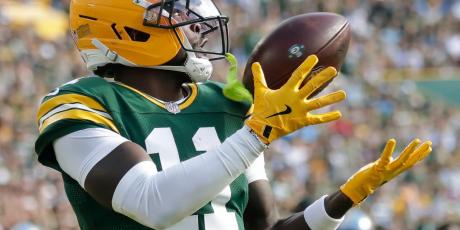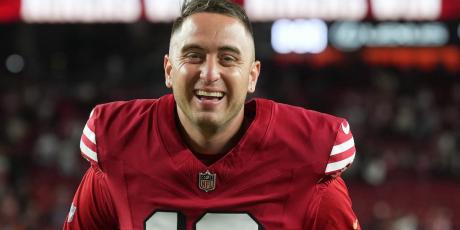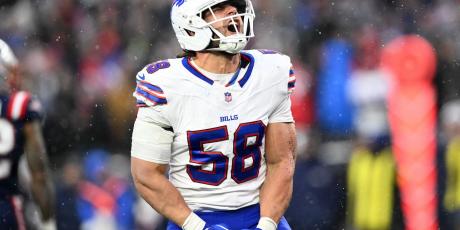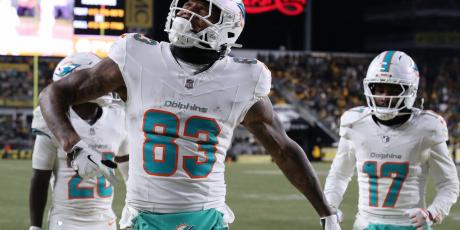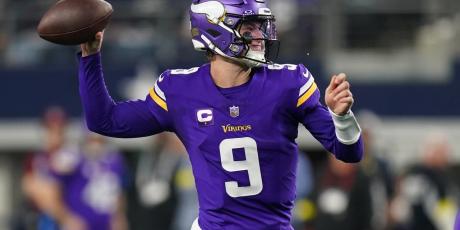How 2022 Fantasy Football Projections Impact Your Salary Cap Draft

The NFL landscape, and therefore fantasy football, is an ever-changing environment. The past decade has seen workhorse running backs make way for committees while dual-threat quarterbacks become increasingly common, and fantasy drafters have had to adapt accordingly.
More Salary Cap Content: Salary Cap Nomination Strategy | How to Avoid Derailing Your Salary Cap Drafts | Tips & Tricks for Salary Cap 2022 | Studs & Scrubs
There are nuances from season to season as well that impact how you should approach fantasy drafts. Each year I set out to identify emerging trends among positional value that your league mates haven’t caught on to yet.
We can compare 4for4’s 2022 projections to prior years and see where we’re expecting changes in player value. Value is determined by a combination of a player’s points scored over a replacement player (VORP) and the last starter at their position (VOLS), ultimately producing a quantifiable score for each player’s 2022 projections. By comparing these trends across tiers and positions, you can assemble pockets of the draft board to target or avoid based on their projected value compared to historical data.
All numbers below are focused on a 12-team, half-PPR league with a salary cap draft, but the underlying trends are common across league types and apply to any draft format.
Quarterbacks
Name recognition goes a long way, and the top quarterbacks this year are all players that even casual NFL fans would get excited about drafting. Household names like Joe Burrow, Russell Wilson, and Aaron Rodgers can all be found as late QB1s. However, the position as a whole is projected for its least valuable year since 2016. Compared to the past two years where the top 12 quarterbacks combined to deliver $399 and $384 in value, this year projects to land at just $248.
Josh Allen, the consensus top quarterback, is projected to deliver just $49 in value, compared to a $56 average for the overall QB1 in the past six seasons. It drops even more significantly from there, with Justin Herbert and Patrick Mahomes projected for $28 and $27 respectively, when historically those slots land in the high-$30 range. This trend continues until QB12, Dak Prescott, where the projected value finally starts to even out with historical averages.
This isn’t to say that I recommend fading quarterbacks until you take a high-end QB2 like Matthew Stafford, Kirk Cousins, or Derek Carr as your starter. This is a viable strategy, but it’s not necessary. For one, the late-round quarterback approach was so popular for so long that many leagues still haven’t caught on to the rise of early and mid-round options, meaning that you might be able to draft a strong quarterback for less than their projected value.
There’s also an unmatched upside that high-end quarterbacks, especially mobile ones, provide a team. Stafford, Cousins, or Carr would need to see historic efficiency to put up the numbers that we expect from Lamar Jackson’s base case. A chance at true quarterback upside is something I shoot for on my rosters, especially since there are likely streaming options available if a pick like Trey Lance doesn’t pan out.
My approach this year has been to wait and grab a back-end QB1 with upside like Lance, Russell Wilson, or Jalen Hurts. While their ADP may be slightly inflated due to historical quarterback success, many leagues are still slow to react to this trend and the boom potential that they offer makes them worth their draft price.
Running Backs
A big reason that quarterback value is projected to dip this year is that the outlook for running backs is historically deep. The top running back options (Jonathan Taylor, Christian McCaffrey, Derrick Henry, and Austin Ekeler), fall largely in line with historical performance, but we then see a massive pocket of players expected to provide greater value than their ranking would indicate.
The run of depth, and therefore value, begins with Najee Harris at RB5. He’s projected to be worth $67, which would be the highest figure since 2018 and a good chunk over the six-year average of $62. This trend continues through Ezekiel Elliott, our RB16 in 2022. Between Harris and Ekeler, every running back projects to be more valuable than the six-year average at their ranking, and almost all of them beat that average by at least $10.
Once we move past Elliott, the landscape evens out with historicals for a bit. However, a second pocket of depth appears between RB26 (Kareem Hunt) and RB36 (Ken Walker). The value here is less extreme than we see in the earlier rounds, but we still see every pick projected to outperform their ranking, and many of them by as much as $5. I wouldn’t go into a draft targeting a zero-RB style approach but know there if you do there are some strong options in the RB3 range.
Running backs are usually the most heavily targeted position in fantasy drafts, especially in salary cap drafts. I’ll never fault somebody for paying up for a top option at the position, but there looks to be a lot of value if you can hold off for a player like Joe Mixon, Aaron Jones, James Conner, Javonte Williams, etc. as your team’s RB1. I’ve entered a lot of salary cap drafts aiming to land two players between RB6 and RB12, but you can even save a bit more money by expanding that range to include players like Nick Chubb, Alvin Kamara, or Eliott. This approach allows you to take advantage of this season’s projected values while also securing your running back position with two strong starters.
Wide Receivers
Cooper Kupp is projected for another historic season, Justin Jefferson is not. Kupp is projected for $78 in value, while the average WR1 delivers $67, although this still has room for regression compared to Kupp’s $86 value in 2021. Jefferson has been a hot pick and is the WR1 overall on many analysts’ draft boards, but he’s projected for $53 in value whereas the typical WR2 delivers $58. However, this says more about the historic WR2 that’s made up by players like Davante Adams, Tyreek Hill, and Antonio Brown in their primes than it does about Jefferson.
We see a pocket between WR4 (Davante Adams) and WR10 (Mike Evans) where players are projected to deliver less value than their historic averages. It’s not nearly as material as we see with quarterbacks and not enough to make me completely avoid those players, but it is worth noting. Starting at WR11 (A.J. Brown), the player values largely even out with no notable trends emerging in the position.
This is the year to let wide receivers fit your draft plan, rather than form your plan around receivers. A zero-RB approach that’s heavy on early-round receivers is just as viable this season as waiting on the position while grabbing studs elsewhere. I’m an advocate for Kupp at his price in salary cap drafts, especially since the top running backs don’t present overwhelming value, but I’m not breaking my back to fit any mold this season.
Tight End
Travis Kelce remains Travis Kelce, and enters another season as the consensus top tight end off draft boards. Unsurprisingly though, we’re not expecting to see the Kelce of old, given another year in age and the changes to the Chiefs offense. He still projects a value of $40 in 2022, but that would be the lowest level since 2016 for the TE1 and notably lower than the six-year average of $47. Meanwhile, Mark Andrews’ projection as the consensus TE2 is right in line with historical data.
The mid-round tight ends have a lot of sex appeal for fantasy managers, consisting of Kyle Pitts, Darren Waller, and George Kittle. But not only are mid-round tight ends historically bad bets, these players all project $8 lower in value than we’ve seen in previous seasons. Simply put, the projected gap between them and later tight end picks is shrinking. Their projected fantasy points are in line with historical data, which means that we expect more depth from the late tight ends than we’re used to seeing. After the top five, most tight end picks fall in line with where we’d expect to see them.
I don’t have many clear targets at tight end this year, but I am cautiously avoiding Kelce, Pitts, Waller, and Kittle. I fear that Kelce’s draft stock is boosted by his historic success, especially in more casual leagues, and he’s often drafted alongside the running backs we see so much value in this year. As mentioned, mid-round tight ends are historically bad bets, and this year’s group has lower projected value than prior seasons.
However, I’m skeptical about the idea that the position is deeper than in prior years, as this may be a function of projections always being slightly optimistic. Those same mid-round tight ends do offer league-winning upside that later picks like Cole Kmet and Dawson Knox don’t carry, so I can see the appeal behind them and wouldn’t be against grabbing one if they fall in the draft.
2022 Draft Targets
I’ve drafted a lot of rosters based on the guidelines I just laid out for 2022, both in salary cap and snake drafts. The following players have wound up on a lot of my starting lineups because they not only fit my overall approach to roster building but also reflect the nuances that we expect to see from the 2022 season.
QB: Jalen Hurts, Trey Lance, Russell Wilson
RB: Dalvin Cook, D’Andre Swift, Joe Mixon, Leonard Fournette, Aaron Jones
WR: Cooper Kupp, D.J. Moore, Amon-Ra St. Brown, Rashod Bateman, Darnell Mooney
TE: Mark Andrews, Cole Kmet, Dallas Goedert, Dawson Knox
Bottom Line
The 2022 season projects to be a bit different from others across positions, and you should keep the following in mind on draft night:
- This season marks a shift from the continued trend of increasing quarterback value, and it seems best to wait for a back-end QB1 with upside rather than splurge on a higher pick. Drafting a high-end QB2 or streaming remain viable options as well.
- High-end running backs remain good bets, but there’s massive value to be had between RB5 and RB16. Securing the position with two players in this range has been one of my favorite approaches to drafts this season.
- Find wide receivers that fit your draft strategy rather than working your strategy around specific wide receivers. Other than a small regression in value between WR4 and WR10, the position doesn’t offer any notable trends.
- Mid-round tight ends are looking like fool’s gold, and I’ve found myself waiting on the position as a whole, but I’ll take a chance at their upside if the value presents itself.








